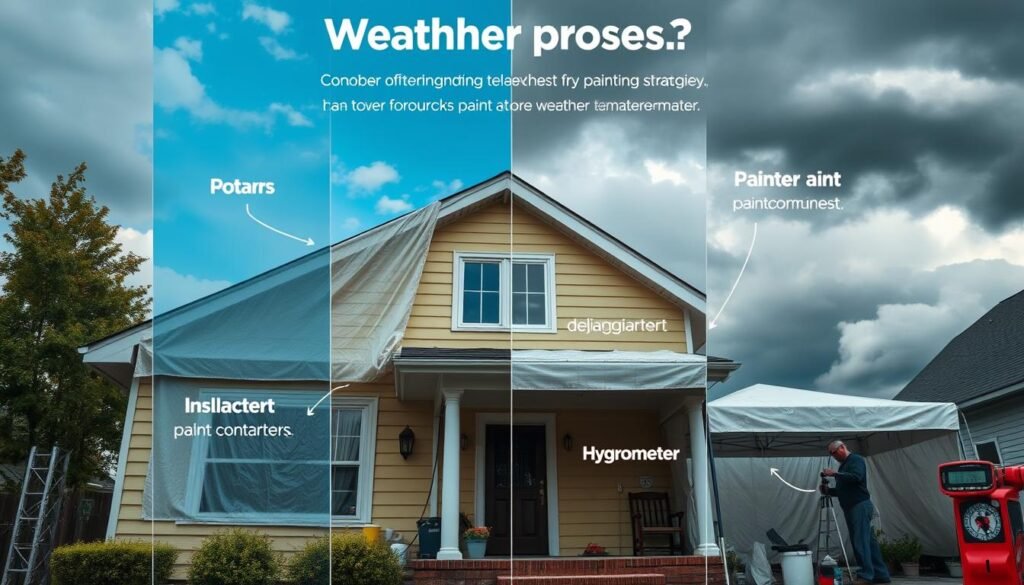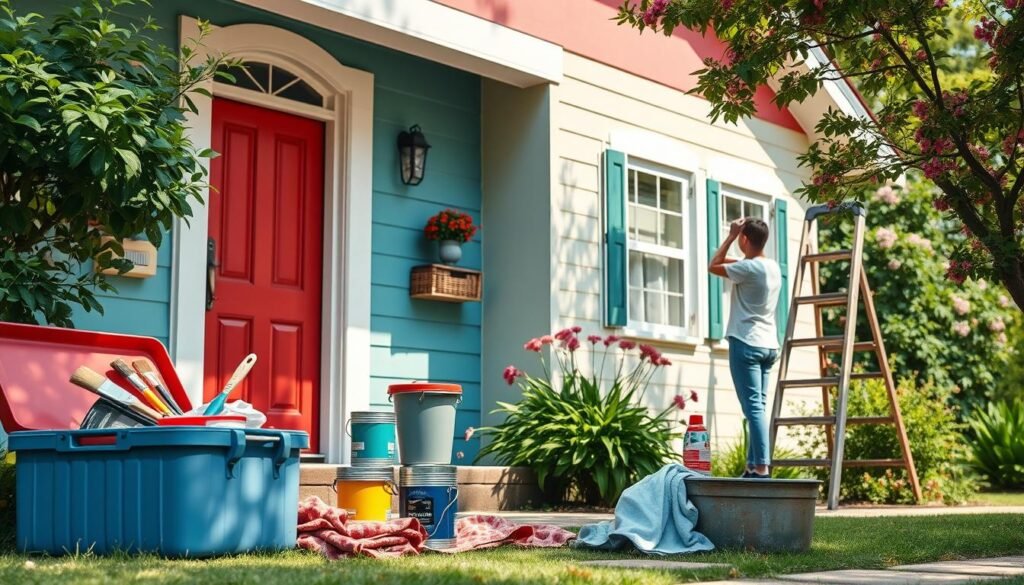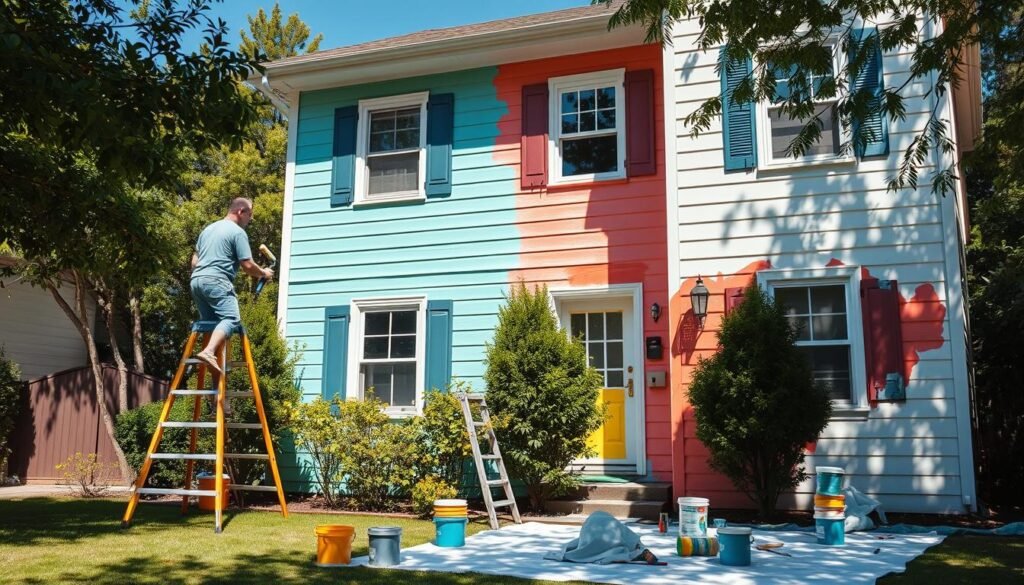Starting an exterior painting project might seem overwhelming. But, with a clear plan, you can make your home look great and keep it safe from the weather. This guide is made for Australian homeowners. It covers everything from getting ready to the final touches, so you get a perfect finish.
By using expert painting tips, picking top paint brands, and doing thorough prep, you’ll boost your home’s look. You’ll also make sure it lasts longer.
Key Takeaways
- A free consultation is available for all exterior painting projects.
- Prepare thoroughly by cleaning, covering furniture, and repairing surfaces.
- Choose exterior paints formulated to withstand Australian weather conditions.
- Summer and early autumn are ideal for optimal painting conditions.
- Consider hiring professionals to avoid costly mistakes and achieve high-quality results.
- Regular maintenance is crucial to addressing issues before they escalate.
Understanding the Importance of Exterior Painting
Exterior painting is key for many reasons. It not only protects your home but also boosts its curb appeal and value.
Enhancing Curb Appeal
First impressions are everything, and exterior painting makes a big difference. It makes your home look better, which is great for potential buyers. A well-painted home is more likely to catch someone’s eye.
Protecting Your Home
Good exterior painting keeps your home safe from the weather. In Australia, the sun and rain can damage your home. Using strong, UV-resistant paints helps prevent this.
Increasing Property Value
Painting your home’s exterior can really pay off. It can increase your property’s value by 5% to 10%. Homes that look good sell faster and for more money.
| Benefit | Details |
|---|---|
| Enhanced Curb Appeal | Significantly increases first impressions and attractiveness to potential buyers. |
| Protection | Protects surfaces from moisture, UV damage, and other environmental factors. |
| Increased Property Value | Can yield a 5% to 10% increase in resale value, enhancing long-term investments. |
| Reduced Maintenance Costs | Regular painting prevents damage and extends the lifespan of exterior materials. |
Preparing for Your Exterior Painting Project
Getting ready for your exterior painting job is key. First, check your home’s outside. Look for spots that need fixing or cleaning. This makes sure your paint job looks great.
Assessing Your Home’s Exterior
Start by checking for damage or wear. Look for cracks, chips, or signs of moisture. Fixing these problems early stops bigger problems later. Regular checks keep your home safe before painting.
Choosing the Right Time of Year
When you paint outside, timing is everything. You want a few days of good weather, little wind, and some cloud cover. This helps the paint stick and dry right. Too hot or windy can mess up the paint job.
Gathering Necessary Tools and Materials
Having the right tools is crucial. You’ll need brushes, rollers, good masking tape, and drop cloths. Quality masking tape stops sticky messes. Also, pick the right paints and primers for your surfaces.
| Tool/Material | Purpose |
|---|---|
| Paint Scraper | Removing loose and peeling paint |
| Sanding Sponge | Smoothing surfaces for better adhesion |
| Pressure Washer | Cleaning surfaces to remove dirt and grime |
| Caulk | Sealing seams and cracks to prevent moisture intrusion |
| Drop Cloths | Protecting areas from paint spills |
Selecting the Right Paint for Your Home
Choosing the right paint for your home’s exterior is key for a lasting and good-looking finish. There are many types of exterior paint out there. Knowing what you need helps you pick the best one. Think about your home’s needs, the weather, and its materials for the best results.
Types of Exterior Paint
It’s important to know the different types of exterior paint:
| Paint Type | Characteristics | Best For |
|---|---|---|
| Water-based (Latex) | Quick drying, flexible, low VOC | Most surfaces, suited for timber and rendered homes |
| Oil-based | Highly durable, longer drying time, higher VOC | High-wear surfaces; strong finish on metal and wood |
| Acrylic | UV resistant, maintains color, adaptable to weather | Wood, brick, and stone exteriors |
Choosing the Right Finish
The paint finish greatly affects your home’s look and durability. Here are some common finishes:
- Gloss: Highly reflective, good for busy areas but shows flaws.
- Semi-gloss: Durable and has some shine, great for trims.
- Satin: Soft sheen, looks rich without too much shine; easy to clean.
Colour Selection Tips
Your colour choices greatly impact your home’s look. Use this exterior colour selection guide to choose wisely:
- Think about your home’s surroundings and style.
- Use the 60-30-10 rule for colour balance.
- Test paint samples on your walls to see how they look at different times.
- Get advice from experts for your specific location and home design.
Surface Preparation: The Key to Lasting Results
Getting your surface ready is key for a paint job that lasts. Start by cleaning the exterior to remove dirt, mildew, and loose paint. This makes the surface look better and helps the paint stick better. Skipping this step can cause big problems later on.
Cleaning the Exterior
Cleaning the outside is the first step in getting ready. Use products like Selley’s Sugar Soap to get rid of dirt. If needed, power washing can help get rid of tough stains. About 70% of pros say cleaning is the most important step.
Repairing Damaged Surfaces
Fixing damaged areas is a must before painting. This includes fixing rot or cracks. If you don’t fix these, painting again can cost 25% to 40% more. A good surface is important for looks and lasting power.
Priming: When and Why
Priming is very important. It’s needed most on surfaces that have never been painted or are very porous. It makes the paint stick better by about 60%. This step helps the paint last longer and prevents peeling and chipping. Choosing good primers means your paint will last longer and work better.
Applying the Paint: The Step-by-Step Process
Applying paint well means following a clear plan for top-notch results. Learning the right techniques makes the finish better. Think about the surfaces you’ll paint, as each needs a special approach. Having the right tools is key for a smooth painting job.
Techniques for a Smooth Application
Start by painting edges with a high-quality brush for sharp lines. Then, use a roller for big areas to get even coverage. A sprayer can also give a smooth finish, perfect for big spaces. Always apply thin, even coats to avoid marks and ensure a smooth finish.
Working with Different Surfaces
Every surface is different. Wood needs sanding, while stucco might need a special roller. Brick often needs a primer for better paint adhesion. Adjust your painting method for each surface to get the best look and durability.
Tools for Effective Painting
The tools you use are crucial for a great paint job. Good brushes, rollers, and sprayers make painting easier and more efficient. They help you use paint wisely, saving you from needing to paint again soon. Don’t forget paint trays and drop cloths to keep things clean and protected.
Managing Weather Conditions During Painting
Weather is key to a successful exterior painting job. Knowing how humidity and temperature affect your work is crucial. You’ll need good weatherproofing to make sure your paint sticks well and dries right.
Impact of Humidity on Drying Times
Humidity greatly affects how paint dries and cures. Too much moisture in the air can make paint take longer to dry. This can lead to problems like paint sagging or dropping.
It’s best to paint outside when humidity is between 40% and 70%. Painting when humidity is over 80% can make the paint sticky. This attracts dirt and grime easily.
Temperature Considerations
Temperature is also very important for painting outside. The best temperature for painting in Australia is between 10°C and 30°C. Painting when it’s too hot can make the paint dry too fast. This can cause brush marks and uneven finishes.
Painting when it’s too cold can let dust and debris get stuck in the paint. This can make the paint wash off when it rains.
Protecting Your Work from Rain
Keeping your freshly painted surfaces dry is crucial for a good finish. Even a little rain can cause problems like paint dripping or not sticking well. This can lead to blisters later on.
Always check the weather forecast before painting. Don’t paint when the weather is unpredictable, like when it’s windy. Wind can carry dust and particles that ruin your paint job.

| Condition | Ideal Level | Impact on Painting |
|---|---|---|
| Temperature | 10°C – 30°C | Ensures proper adhesion and drying |
| Humidity | 40% – 70% | Affects drying times and adhesion |
| Rain | N/A | Can damage wet paint and affect curing |
Safety Precautions When Painting Exteriors
When you’re painting the outside of your home, safety comes first. Using the right safety steps helps keep you safe and makes the job easier. It’s important to know about personal protective equipment, ladder safety, and how to handle paint chemicals.
Personal Protective Equipment (PPE)
Wearing the right PPE is key to keeping you safe while painting. You’ll need:
- Gloves to protect your skin from paint chemicals
- Safety goggles to shield your eyes from splashes
- Respirators or masks, mainly for solvent-based paints
- Non-slip footwear to avoid slipping
For areas with bad air, airfed masks can help a lot by giving you clean air.
Ladder Safety Best Practices
Here are some ladder safety tips to follow:
- Always keep three points of contact when climbing
- Make sure the ladder is on level ground and stable
- Use ladders that can hold your weight
- Don’t lean out too far to keep your balance
Handling Paint and Chemicals Responsibly
Handling paint chemicals safely keeps you and others safe. Here’s how:
- Always read the labels on paint containers for safety instructions
- Keep paint away from things that can start fires
- Work in areas with good air flow to avoid inhaling fumes
- If you get paint on your skin, use a non-greasy cream and wash it off quickly
By following these tips, you can have a safe and successful painting job.
| Safety Measure | Description |
|---|---|
| Personal Protective Equipment | Use gloves, goggles, and masks to protect against hazardous materials |
| Ladder Safety | Maintain three points of contact and ensure stability at all times |
| Chemical Handling | Read labels and store paint away from heat sources to prevent risks |
Inspecting and Touching Up Your Work
After painting is done, a detailed check is key. It helps spot issues like runs, missed spots, and uneven coverage. Fixing these problems quickly can make your exterior look great.
Identifying Imperfections
Look over every inch of the painted area carefully. Focus on trouble spots like corners and edges. Finding problems early means you can fix them fast.
Using photos to document issues can help solve problems faster. It makes sure you catch all the important flaws.
When to Touch Up
Touch-ups should wait until the paint is fully dry. This can take days or weeks, depending on the weather. Fixing problems now makes your paint last longer.
Having touch-up paint ready can help homeowners fix small issues. This can cut down on future painting needs by up to 80%.
Final Inspection Tips
Do a final check with the client. This makes sure everyone is happy with the work. It also helps avoid any disagreements later.
Regular checks of maintenance points can also help. It keeps your paint looking good for longer and protects it from damage.
Maintenance Tips for Long-lasting Results
Keeping your exterior paint in top shape is key to its longevity. Regular checks and the right maintenance methods are crucial. By following these tips, you can keep your paint looking great and avoid expensive fixes.
Seasonal Checks and Cleaning
Seasonal checks are a must. Do them at least once a year. This helps spot problems like chipping or fading early, saving you money.
Cleaning your paint regularly can also stop mildew and algae. A gentle hose or low-pressure washer is best. It cuts down paint damage by half.
Addressing Wear and Tear
Fixing wear and tear quickly is important. Ignoring peeling paint can shorten your paint’s life. Quick fixes can add 5 to 10 years to its life, depending on the weather and materials.
Check and fix caulk and seals to stop moisture damage. This is about 20% of paint problems. Using mildew-resistant paints can also cut mildew growth by half.
Knowing When to Repaint
Knowing when to repaint is key for your home’s look and protection. Paint usually needs a refresh every 5-10 years, based on the climate and paint quality. Spotting fading or wear early helps keep your home looking good and strong.

| Maintenance Task | Frequency | Benefits |
|---|---|---|
| Seasonal Inspections | Every Season | Identifies issues early, reduces costs by up to 30% |
| Regular Cleaning | Bi-Monthly | Deters 80% of mildew, prevents damage |
| Addressing Peeling | As Needed | Extends lifespan by 5-10 years |
| Repainting | Every 5-10 Years | Maintains appearance and protection |
Hiring Professionals vs. DIY Painting
Choosing between hiring pros or doing it yourself can greatly affect your project’s outcome. DIY might seem cheaper at first, but hiring experts has many benefits. They have the skills to do the job right, from start to finish.
They focus on the important details, like making sure the surface is ready. This is hard for beginners, who might not know how much time and effort it takes. Getting the surface right can take up to 40% of the total work.
Looking at costs, DIY might save you 20-50% on labour. But, it can also lead to extra costs for mistakes, which can be $300 to $1,200 to fix. On the other hand, pros might cost more upfront, but they work faster, usually in 3-5 days. DIY can take up to 2 weeks.
Finding the right painter is key for a good job. Get at least three quotes and ask for recommendations. This way, you’ll find someone who charges fairly and does a great job. Checking references and customer feedback can help avoid DIY regrets. Taking the time to find the right painter means you’ll be happy with the result for years.



